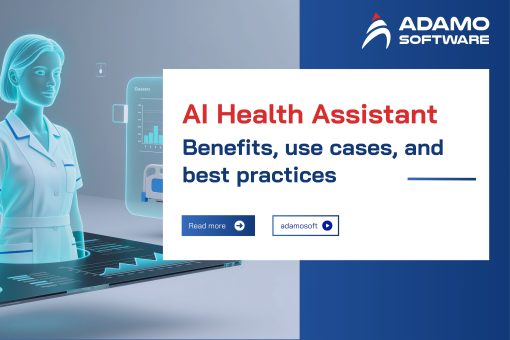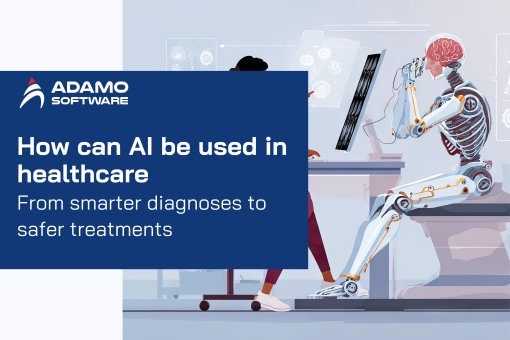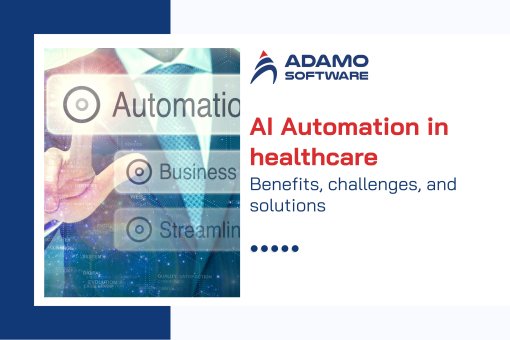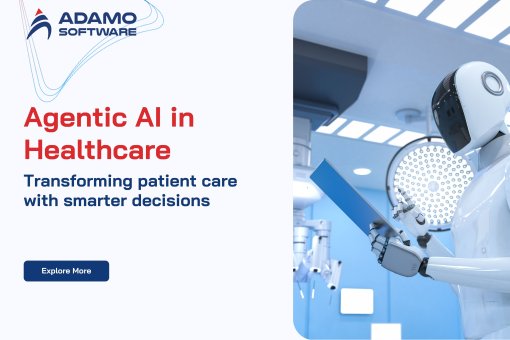Veterinary Practice Management Software: Benefits, Custom Solutions & How to Choose
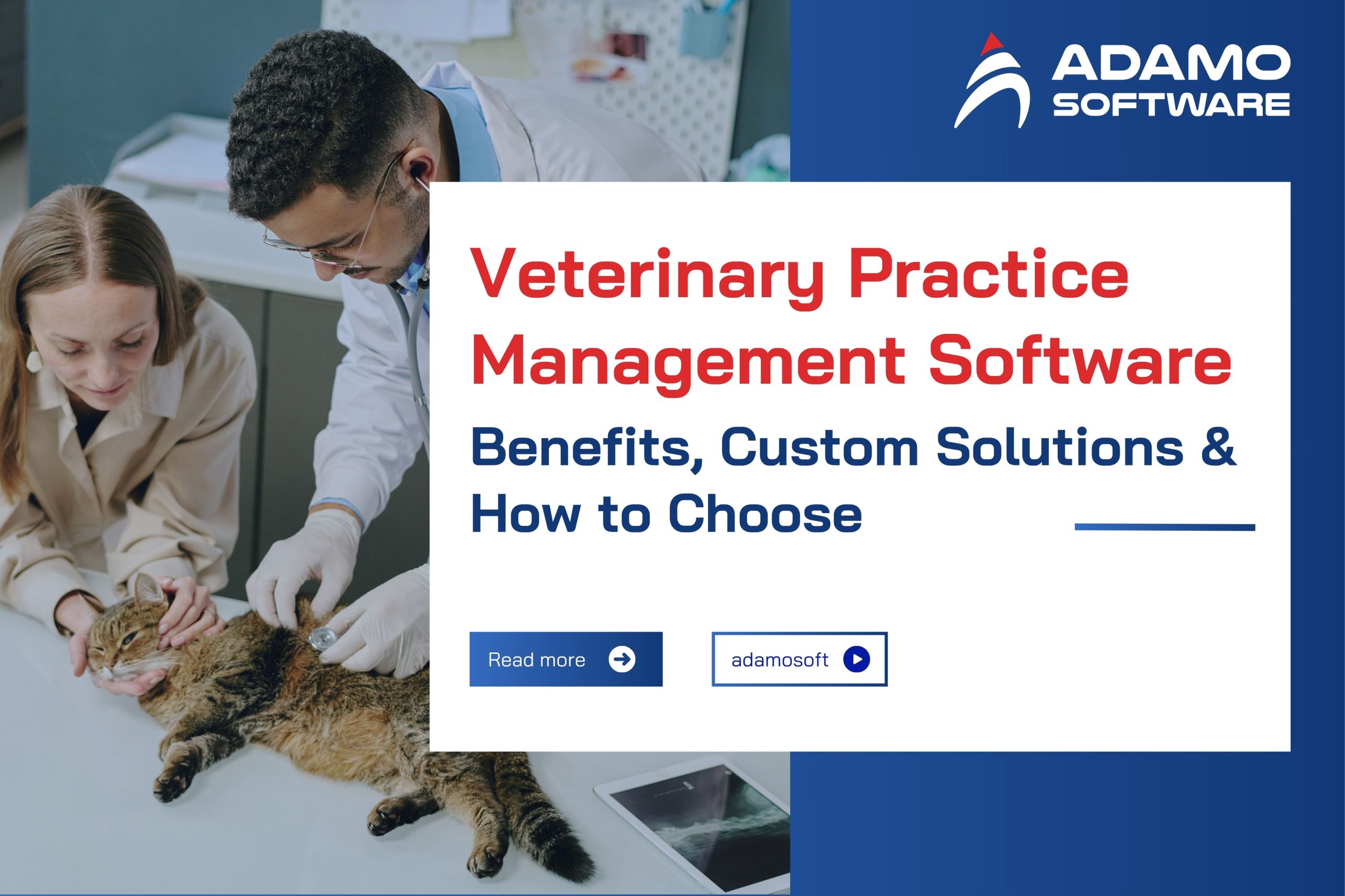
Veterinary practice management software helps animal health care facilities efficiently manage daily operation. Let’s learn about this software!
Veterinary practice management software is a digital tool that helps animal health care facilities efficiently manage daily operations, including managing medical records, appointments, prescriptions, inventory, and finances. Good practice management software streamlines and connects everything, eliminating the need to juggle spreadsheets, sticky notes, and disparate tools. Let’s learn about this software!
Through this blog post, you will find out the following pieces of information.
- What is Veterinary Practice Management Software?
- 7 Benefits of using Veterinary PIMS to increase workflows
- Why businesses preferred Custom Veterinary Practice Management Software
- Tips to choose the right Tailor Veterinary PIMS
All information has been thoroughly researched and updated to the latest trends. So, let’s read our blog post and find some useful information!
I. What is Veterinary Practice Management Software?
Veterinary practice management software is a digital tool that manages and streamlines all the daily operations of a veterinary practice. It serves as the single platform clinics use to handle everything from patient records and scheduling to billing, inventory, and client communication. A well-designed veterinary practice management system keeps everything organized and accessible, replacing separate tools and allowing veterinary teams to handle their workload efficiently.
Veterinary practice management software works by integrating various functions into a unified system. It stores and processes all data, from pet medical records, appointment schedules, customer information, to inventory management and billing, on the same platform. Here’s some functions of the veterinary practice management software.
- Managing patient records: Doctors can quickly access treatment records, medical histories, and test results with just a few steps.
- Appointment scheduling and reminders: The system automatically schedules appointments and sends reminders to customers via email or text, helping to minimize missed appointments.
- Payment and invoice management: Integrated billing, payment processing, and debt tracking features help the accounting department work faster and more accurately.
- Warehouse and supplies management: Track inventory of drugs, vaccines, and medical supplies, automatically alerting when stock is running low.
- Customer communication: Send post-examination care messages, notify regular vaccinations, or update new services, helping to maintain long-term relationships with customers.
Essentially, veterinary practice management software is a comprehensive platform, enabling clinics to operate professionally, cut costs, and improve pet care quality.
II. 7 Benefits of using Veterinary PMS to increase workflows
Applying veterinary practice management software brings many clear benefits to doctors, staff, and customers. Below are 7 outstanding advantages of using veterinary PMS.
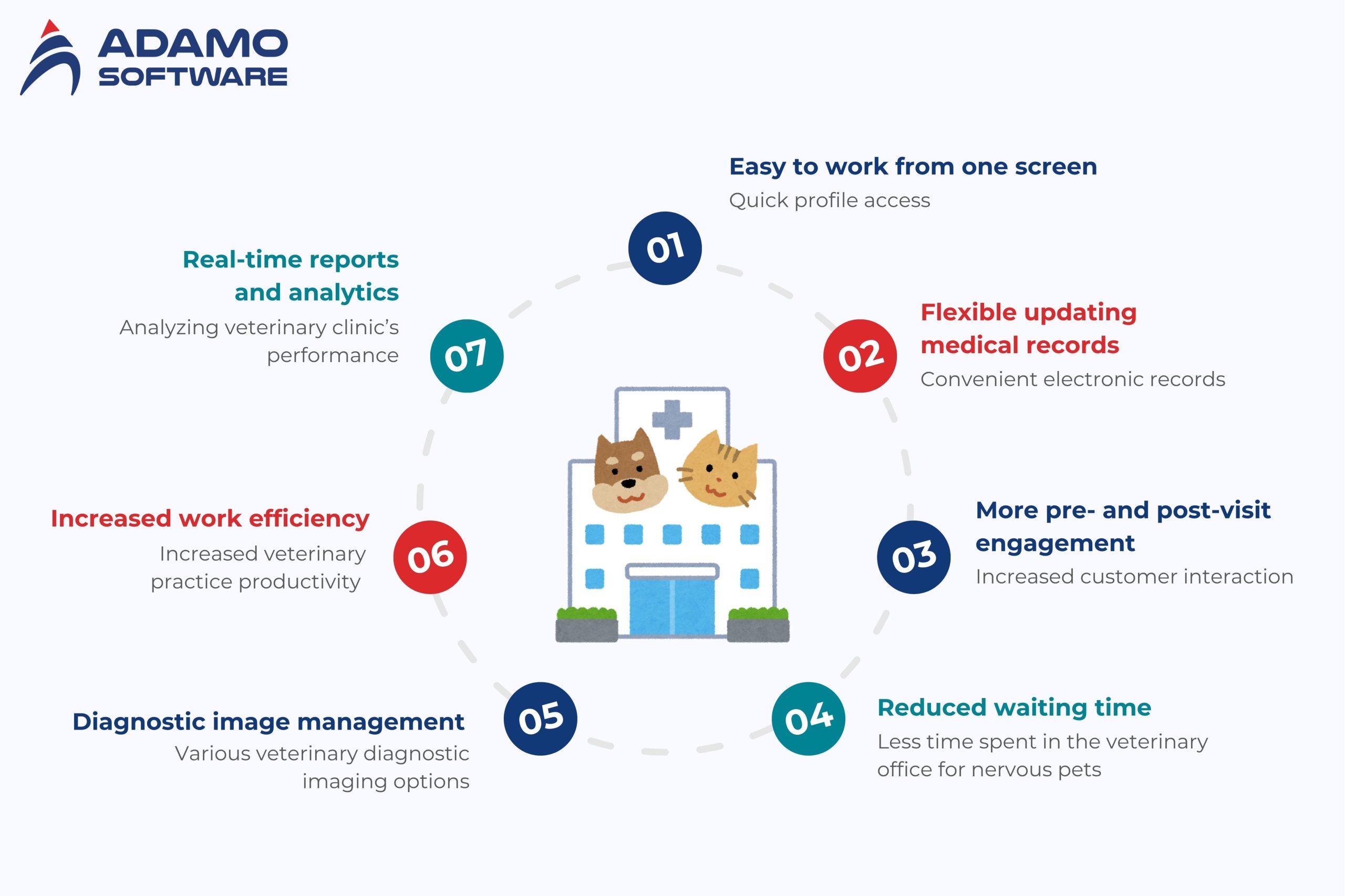
- Easy to work from one screen – Quick profile access
- Flexible updating medical records – Convenient electronic records
- More pre- and post-visit engagement – Increased customer interaction
- Less time spent in the veterinary office for nervous pets – Reduced waiting time
- Various veterinary diagnostic imaging options – Diagnostic image management
- Increased veterinary practice productivity – Increased work efficiency
- Real-time reports and analytics – Analyzing veterinary clinic’s performance
Let’s discuss more detailed information about each benefit with Adamo Software!
1. Easy to work from one screen
With the veterinary practice management software, doctors and staff can do almost everything from a single interface. Patient records, treatment progress, test ordering, billing and scheduling appointments, are integrated into one system. This significantly reduces the risk of errors when entering and tracking patient information.
Centralizing all work tools on one screen also helps veterinary teams maintain a continuous and accurate workflow. All data is updated in real time, allowing doctors to quickly make treatment decisions based on complete and reliable information. As a result, work efficiency is improved, operating procedures become smoother, and the pet care experience is also significantly improved. Besides, fully electronic medical records allow direct entry of patient data; therefore, tracking down X-ray folders, lab results, and other important documents is no longer a difficult challenge.
2. Flexible updating medical records
Veterinary practice management software allows doctors to update medical records anytime, anywhere. By storing data on an electronic platform, doctors can access and edit treatment information, add notes, or upload test results with just a few steps. This helps ensure that information is always updated accurately and promptly.
The system allows every member of the care team, such as internal medicine, radiology, and surgery, to add their individual coded and time-stamped SOAP entries directly to the medical record, ensuring completeness. Preformulated templates are also available. Besides, veterinary practice management software allows for tracking any data type, such as vitals, patient weight, and tumor size. Data entry is completely user-defined, supporting results like positive/negative, numeric values, or text, and can be simplified by specifying high, low, and default values.
3. More pre- and post-visit engagement
Excessive automation can make the appointment process feel impersonal or confusing to pet owners, despite reducing the need for staff interaction. However, veterinary practice management software shouldn’t diminish your personal touch but should enhance it instead. You can use digital communication tools within the software to engage with patients both practically and meaningfully.
Digital engagement features, such as intake forms, two-way texting, and automated updates, inform clients and give them a sense of control. These tools don’t replace personal interaction. Instead, they simply offer more efficient ways for staff and clients to communicate.
Veterinarians use digital communication to share and receive helpful information with clients about a pet’s condition and treatment needs pre- and post-visit, resulting in productive appointments and better health outcomes. Customization ensures an appropriate degree of automation while preserving the personal touch.
4. Less time spent in the veterinary office for nervous pets
Despite your staff’s best efforts, the veterinary waiting room is inherently stressful for many pets and their owners. While comfy seating and free treats help, the most meaningful way to improve the waiting room experience is to reduce the amount of time clients spend there.
Digital intake, digital queuing, and virtual waiting rooms reduce waiting room time and help patients feel more in control of their appointments. They can quickly check in from their phones and pass their wait time in a location where they feel more comfortable, such as in their car or outside the facility. These tools empower clients, streamline your office’s workflow, and create a more peaceful waiting room.
5. Various veterinary diagnostic imaging options
A user-friendly veterinary practice management software simplifies adding diagnostic images to a patient’s record. Besides, it provides these key manipulation features below.
- Importing: Smart Imaging allows direct import from cameras, scans, discs, or PACS servers.
- Annotation: Use text, drawings, or predefined shapes to highlight areas on the image.
- Manipulation: Easily adjust images by rotating, zooming, panning, reversing, and adjusting contrast or color for optimal viewing.
- Storage: Images are stored in their original format, with annotations saved separately, allowing for easy printing, emailing, or pasting into reports.
Generally, veterinary practice management software helps to simplify the diagnostic imaging workflow, from data entry, annotation, editing to archiving, making it easy for doctors to manage and use imaging data in medical records.
6. Increased veterinary practice productivity
Your veterinary PIMS handles many managerial issues and repetitive tasks, freeing up team members to spend more time treating patients and focusing on clients. With patient medical information always accessible, tediously leafing through paper files is no longer necessary. This helps veterinary staff work faster and more efficiently, with all the necessary information accessible in seconds. By reducing repetitive administrative tasks, staff can focus more on pet care and improving service quality, thereby increasing the overall productivity of the clinic.
7. Real-time reports and analytics
Veterinary practice management software provides on-demand reports and analytics, offering objective insight into key performance metrics. You can review historic trends to anticipate upcoming changes related to productivity, scheduling, and any other trackable practice data. With real-time data analytics, managers can monitor operational performance and business conditions as they happen. This helps them make faster and more accurate decisions, optimize resources, and adjust strategies in a timely manner to improve the clinic’s operational efficiency.
You can explore more about “Outsourcing Healthcare Software Development: When it works” here.
Ready to Outsource?
Get top-tier IT talent without the hassle. Contact us now!
III. Why businesses preferred Custom Veterinary Practice Management Software
As veterinary clinic management needs to become increasingly diverse and complex, many businesses have begun to look to custom veterinary practice management software to precisely meet their own processes and goals. Below are some reasons for choosing custom software.
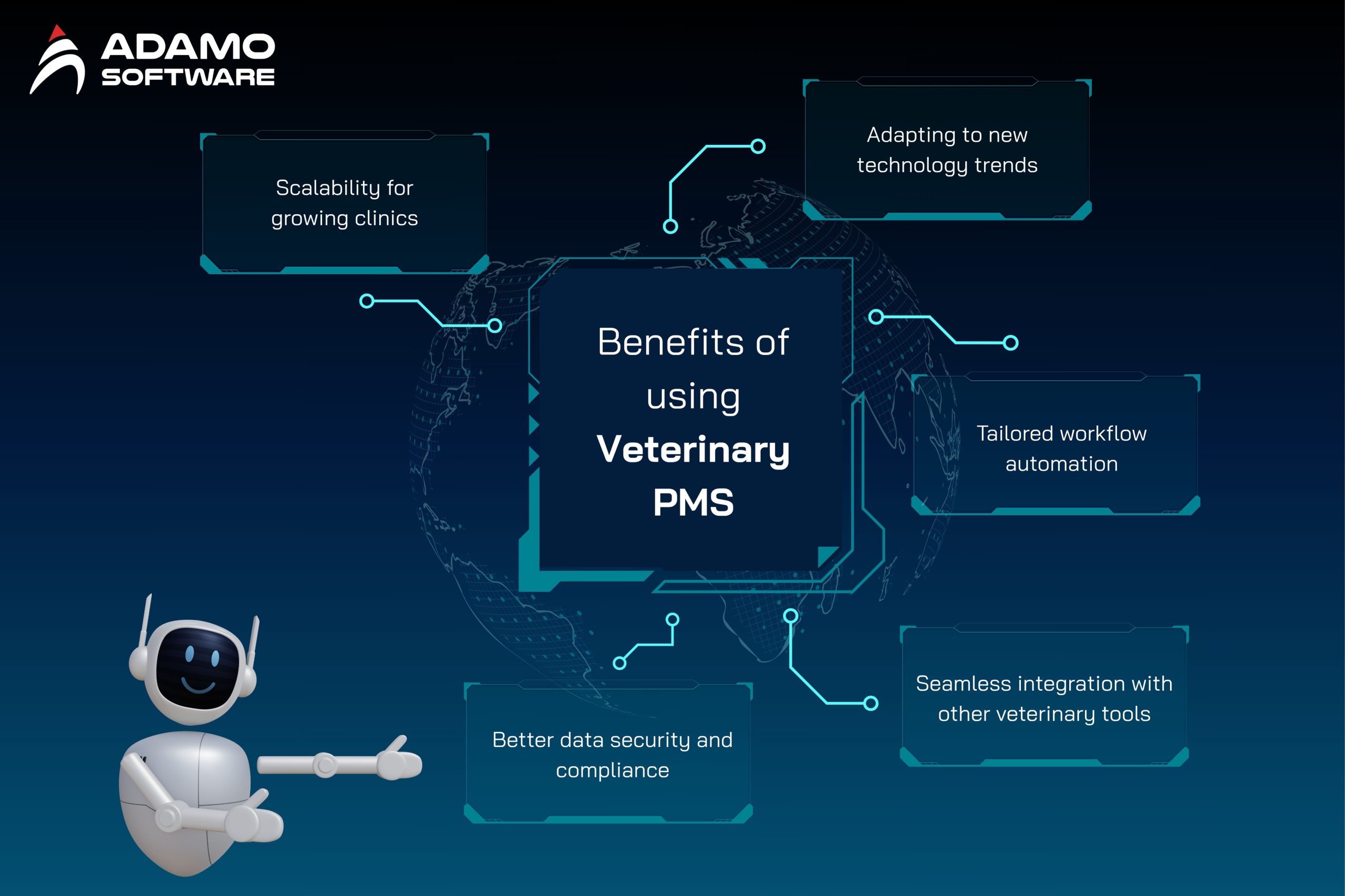
- Trends in Veterinary Practice Management – Adapting to new technology trends
- Tailored workflow automation – Customizing process
- Seamless integration with other veterinary tools – Integrating system seamlessly
- Better data security and compliance – Protecting data ultimately
- Scalability for growing clinics – Expanding systems flexibly
1. Trends in Veterinary Practice Management
Businesses may want to use the custom veterinary practice management software to adapt to new technology trends. With telemedicine, cloud-based systems, and artificial intelligence reshaping veterinary practice, clinics must adopt tailored software that can keep up with these advancements. A growing number of clinics are investing in mobile veterinary software to provide remote access, letting veterinarians consult and update patient records while making house calls.
Overall, these trends are changing the way veterinary clinics operate and reshaping the entire pet care experience. With the help of modern management software, veterinarians can connect with customers faster, track pet health records more accurately, and make treatment decisions based on real-time data. In the near future, the application of smart technology and customized software solutions will become the core factor for clinics to maintain a competitive advantage and develop sustainably.
2. Tailored workflow automation
Since every clinic operates differently, custom veterinary practice management software ensures that automation perfectly aligns with the clinic’s unique needs. By covering everything from scheduling and billing to patient records and reporting, a customized system boosts productivity and eliminates inefficiencies. While standard software often has unnecessary features or lacks key ones, a custom-built system allows veterinarians and staff to streamline tasks and prioritize patient care over administrative burdens.
3. Seamless integration with other veterinary tools
One of the biggest drawbacks of generic veterinary software programs is their limited integration capabilities. Thus, custom veterinary practice management software is needed. Many clinics require their vet practice management software to work seamlessly with their laboratory diagnostics, pharmacy management, and inventory tracking systems. Custom solutions ensure seamless connectivity with these essential tools, preventing the data silos often created by off-the-shelf veterinary PIMS software.
4. Better Data Security and Compliance
Since veterinary clinics handle sensitive patient and client information, data security must be a top priority. Many generic veterinary software programs fail to offer the highest level of encryption or comply with critical industry regulations like HIPAA and GDPR. Custom veterinary practice management software provides advanced security, including encrypted cloud backups, access controls, and automated compliance updates, proactively safeguarding patient data from breaches and unauthorized access.
5. Scalability for Growing Clinics
Growing veterinary clinics require software that can scale with their increasing demands. By supporting new service offerings, multiple locations, or telehealth integration, custom veterinary practice management software ensures a growing practice never outgrows its management system. Unlike pre-packaged programs that require expensive upgrades or replacements, a tailored solution evolves seamlessly with the clinic’s needs.
IV. Tips to choose the right Tailor Veterinary PMS
To choose the most suitable tailor veterinary practice management software, clinics need to carefully consider many factors to ensure the system meets both current needs and long-term development orientation. Let’s explore some tips to choose the right tailor veterinary PMS with Adamo Software!
1. Identifying key features
For long-term efficiency, choosing the correct veterinary practice management software is essential. Clinics should prioritize essential features like customizable dashboards, automated appointment reminders, integrated payment solutions, and cloud-based accessibility. Furthermore, seamless integration with third-party applications prevents workflow disruption.
2. Ensuring integration capability
An effective veterinary clinic management software needs to seamlessly connect with other systems such as laboratory management, pharmacy inventory, billing, or telemedicine. This integration allows data to be automatically synchronized, reducing errors and saving staff time. Additionally, when all information is updated on the same platform, doctors and staff can make faster and more accurate decisions during pet care.
3. Assessing the level of support and training
When choosing veterinary clinic management software, technical support and user training are indispensable factors. A reputable provider should ensure that the clinic team is guided in detail during the installation, use, and update of the system. In addition, 24/7 support and periodic training courses will help staff master the technology quickly, reduce operating errors, and maintain long-term efficiency.
4. Partnering with the right software provider
Choosing the right software development partner plays a vital role in the long-term success of a veterinary clinic management system. A reputable vendor not only understands the clinic’s operational needs but also has the ability to advise on suitable solutions that can be flexibly adjusted to actual requirements. In addition, a commitment to maintenance, updates and post-implementation support will ensure that the software always operates stably and grows with the clinic.
V. Final thoughts

In general, the veterinary practice management software helps to optimize workflows, improve customer experience and ensure quality pet care. Choosing a custom healthcare solution brings outstanding advantages, when the system is designed to suit the process, scale and development direction of each clinic. Besides, to achieve sustainable efficiency, clinics need to carefully evaluate their needs, integration capabilities, support services and choose a reliable software partner. As one of Vietnam’s leading technology companies, Adamo Software can be your ideal choice. Here’s how we can help.
- Developing custom veterinary practice management software: Designing and building a system that fits the process, scale, and unique needs of each clinic.
- Integrating veterinary practice management software with existing systems: Seamlessly connect with testing, pharmacy management, billing, telemedicine, and financial reporting systems.
- Automating workflow: Reducing administrative tasks such as scheduling, appointment reminders, billing, and sending notifications to customers.
- Long-term technical support and maintenance: Providing training, operational support, new feature updates and periodic system upgrades.
- Optimizing costs and implementation time: Thanks to outsourcing experience and a team of highly specialized engineers, Adamo helps clinics save costs while still ensuring quality and development speed.
Still hesitating whether to choose Adamo Software? Let’s contact us for more detailed information!







